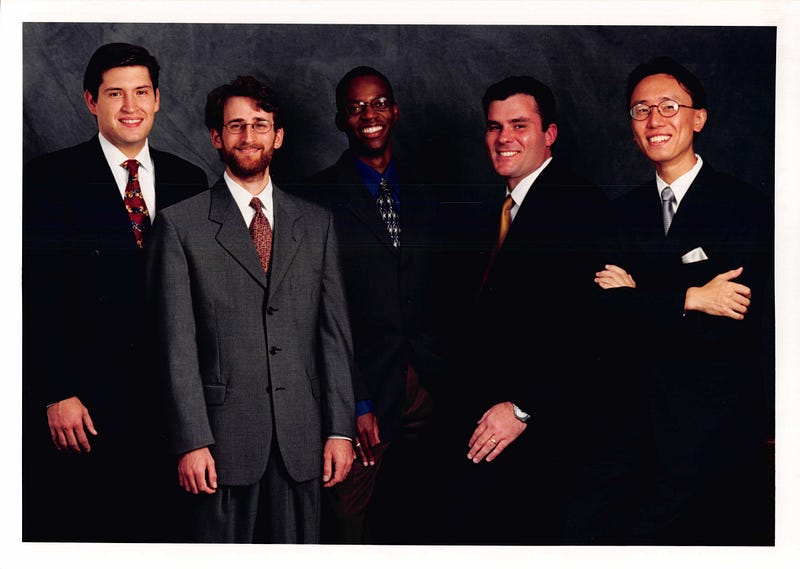I was super nervous.
It was one of the first meetings we had with venture capitalists.
This wasn’t just any venture capital meeting; this was among some of the top new firms in the space.
Let me put this in context.
It was the late 90s, right in the heart of the “dot-com” wave. Companies like Netscape (an early version of the internet browser, co-founded by Marc Andressen), and AOL (a bulletin board service) were the equivalent of Google or Facebook in terms of name recognition at the time.
There weren’t thousands of VCs to choose from back then. In 1996, total U.S. venture capital investments reached $9.4 billion. In the first quarter of 1997 (when we were raising money), it totaled about $2.4 Billion. Today, there are some funds that big.
Back then, there were only a few players in the space that had the “Midas touch.” Firms like Kleiner Perkins, Greylock, Venrock, and Mayfield were among the top players. All of those guys were in California with offices in Boston.
Boston’s list included Battery, Charles River, Atlas, Highland, Matrix.
There were a few new offshoots of these successful firms just forming in Boston. This particular meeting was with one of those offshoots.
(These guys are serious players in the game today.)
Before this day, I spent months studying.
I didn’t know what venture capital was, how it worked, nor how to approach it.
But, everything I read and everyone I spoke to focused on how small of a community it was. A “good old boys club,” and “old money,” were the monikers di jour.
If you weren’t part of the network, it would be tough to get in front of these guys.
But, we hustled our way into this coveted meeting.
(See the “Know Who You Know” section below.)
Like I said, I was really nervous.
Two partners of the firm hosted us.
One of the partners in the room was the former CEO of a successful internet technology company. It was the industry’s first version of a kind of WYSIWYG HTML page designer (think of what Squarespace or Wix is today).
We’ll call him, “Mr. Front.”
The second was recruited to the firm after he led two very successful exits of Boston-based companies.
We’ll call him, “Mr. Dynamo.”
Venture capitalists at the time usually wore business attire. Mr. Dynamo was wearing a french-cuffed shirt. He dressed impeccably, like a banker. He had cufflinks that looked like they were platinum with some custom design on them that I couldn’t make out until later.
I was joined by two of my co-founders for the meeting.
After some pleasantries and an introduction to the firm delivered by Mr. Front, we started our presentation. I was impressed with Mr. Front as his startup had a reputation among entrepreneurs at the time.
We had a short demo to show and an investor pitch.
(Yes, we had an MVP before there was such a thing. And, it wasn’t a laptop, we carried a full-blown desktop machine with loud, spinning hard drives.)
So, I went through the crux of our product, and getting to what I would say was the” juice” of my presentation. It wasn’t my first presentation, so I had an approach.
“In the future, applications will be modular like legos,” I proclaimed.
All of a sudden, before I could finish my sentence, Mr. Dynamo pulls out a pair of nail clippers.
Without missing a beat, he began to groom himself.
I sh*t you not, he was clipping his fingernails.
The nail clippers — which I was mesmerized by — were gold plated or maybe platinum. They had a skull and crossbones feature on them. That’s when I noticed they matched his cufflinks.
“Is he cutting his nails right now?” I thought.
He caught me midstream in my presentation.
I was thinking that either he was trying to show me that he was wrapped in money and didn’t give two sh*ts about whatever I was presenting, or Mr. Dynamo was signaling my presentation didn’t move him.
Nonetheless, I was frozen inside but managed to keep my composure while shooting a glance at my puzzled co-founders.
Even more surprising, Mr. Front didn’t even flinch.
“Wow, this is the VC world. The good old boys, huh?” I remember remarking.
It solidified for me how different this world was and how hard it was going to be for us to raise capital.
They said NO.
Mr. Dynamo, with his freshly trimmed fingernails, explained he didn’t invest in any people he didn’t know. Every single company he’d financed, he’s known the founder. He gave us one example, one founder, known to him, made 1,500 phone calls to uncover pain before he started his company.
When I left the room with my co-founders, I vowed to do two things:
Firstly, we would never take money from Mr. Dynamo.
(I held to that because many years later, there was an opportunity presented to me, and I chose to pass.)
Secondly, my co-founders and I would do everything we could to succeed. This meeting would not deter us.
And that we did.
(To learn the identities of Mr. Dynamo and Mr. Front, you’ll have to wait until “The Story Continues” section at the end of the article.)
I’m an African American — Haitian American, to be exact. I’m a serial entrepreneur and CEO. Since that meeting, I have raised over $30 million and turned it into over $400 million in value. A lot of what I’ve learned over 20 years of raising capital is what I’m using now to help raise over $200 million for a new project.
I want to share those lessons with you.

1. Should You Raise Money from VCs?
Before you start raising money, you first have to ask yourself if you should raise money. Over the period that I’ve been raising capital, there’s one thing that I’ve learned. That is that not all new ventures or new startups are venture bankable companies.
Some companies will grow into outstanding, profitable niche companies. They will never be billion-dollar public companies, and those types of companies may not be great avenues or good targets for bringing in venture capital.
Venture capital is a very different type of money. It’s a costly source of funding.
Most VC’s focus on deploying their capital in companies that have a chance to be world-changing, super-massive enterprises.
Most of the capital out there now is optimized to invest in that way. Most firms will invest in 10–20 companies in a single fund. They are looking for one or two companies that have the potential to return the entire fund or better. Most of the top VC firms can attribute their outsized returns to a single hit or two.
Keep this in mind. Think to yourself, “Is my company likely to be one of these companies?”

2. Know Who You Know
It is all about networks. Just about everything in business and entrepreneurship is about personal networks.
The first thing you and your co-founders should do is chart your social graph.
When my co-founders and I started our first company in the 90s, the internet was taking off, so the term social network meant nothing to anyone.
But, first, we built a network list — we pulled our legal pads and starting writing everyone we knew, our entire circle of influence.
The goal was to map our way into the venture capital we desperately needed. (It is also a handy exercise for finding advisors, customers, and employees.)
Today, there are a host of technologies and platforms that can assist with this mapping exercise, places like AngelList, and of course, all of the social networks like Twitter, Linkedin, Facebook.
There is now a new service called Signal, that’s all about finding pathways to venture capital funding.
These make it infinitely easier to know who you know.
Ultimately, it does tie to the network.
So, “know who you know because hey, you never know who you know.”

3. Do Your Research: VCs are Not Created Equal
Not every venture firm is the right venture firm for your company.
You need to research the market.
Create a segmentation of the market. Focus on those firms that are likely to get your type of business.
For instance, if you’re a FinTech company, this goes without saying, but you should be focusing on FinTech-focused venture firms because they have the specific mandate to invest in your class of company. If you are a B2C or consumer product company, you should approach venture firms that love B2C ventures.
Classify the market by stage. Some venture firms are focused on the seed stage, while some venture firms only invest in a growth opportunity. Some come in beyond growth, others are a B or C class, or when your company is just about to enter the scaling mode. That’s where they want to be. Then you have groups that are very, very early on, in the angel phase, where they focus on investing in people who have an idea in mind.
Then there are the tiers.
Tier-one VCs like Andressen Horowitz or Kleiner Perkins may not be good fits for your business. You might also target smaller, regional firms that are looking for a lower return rate and particular niche business categories. These firms may be better fits for your company and your location. You want to do your homework. Do all the research and understand who your targets are.
In my insurtech startup, I did just that to great success.

4. Cold Call the CEOs and Ask the Right Questions
Once you’ve identified those targets, there is a little secret I learned back in the nail clipper days.
Spend as much time as you possibly can looking at their websites, their recent deals, and all the materials they put out.
These venture firms are companies, too. They’re businesses like your own, trying to grow and differentiate themselves in the marketplace. A lot of them put out content. Some of the partners are hosting podcasts.
More importantly, look at the portfolio companies.
What companies are close or approximately close to what your company does? Try to understand who those companies are, who’s behind those companies, and who the founders are.
Here’s the secret: pick up the phone and cold-call the CEOs and co-founders of those companies.
Have an in-depth conversation with them. Discuss the fact that you are looking for money, and you’re interested in getting the VC to consider your company.
Talk to them about their experiences with that firm.
Here are the questions you want to ask:
- Who are the best and right partners to engage within that firm for your type of business? (They are not all created equal.)
- What types of questions would they ask your company?
- What would they ask you as a founder as they evaluate your company?
- What are their evaluation and due diligence processes?
- How do they act when things aren’t going well?
These are the most critical questions.
How do they approach their role as an investor and fiduciary when things go wrong? When things are bad, are they patient, or are they helpful? Do they have a playbook where they try to change out management?
The only way to uncover that is to talk to the real people that have experienced their “product.” The product more than their capital. It’s their expertise as investors, operators and partners.
You want to understand their product as much as possible. Just like any product, you want to get references and referrals, and you don’t want to go to the ones they give you, you want to do your background research.
Once you identify that target partner, you then leverage your social graph to get introductions directly to him or her.
That’s the partner that understands how to evaluate the business that you’re trying to build.

5. Paint A Vision: The Power of Story
I can’t stress the importance of painting a vision for your business.
Don’t just say, “we’ve got this product that does this, and it’s better than that.”
You must create a storyline that demonstrates why the company that you’re building, the product that you’re building needs to exist right now.
You need to explain why the company must exist, grow, and scale because something has changed about the market that you’re going after that creates the need for your product.
The vision that you’re describing is a story, and my good friend Andy Raskin likes to call it a “strategic narrative.”
It would help if you worked on becoming good at storytelling as quickly as possible. I like to say, “storytelling is why CEOs are better than chimpanzees.”
Not everyone is good at it.
In my first venture, we were talking about the power of building e-commerce applications with software lego block.
In my insurance business, we were looking at the power of bringing data and automation to commercial insurance underwriting. In my new company, I’m talking about the power of how blockchain will transform the renewable energy business.
It can be a potent tool to assist with raising capital.

The Story Continues
I didn’t know this at the time, but the company that earned Mr. Dynamo his reputation was Vermeer Technologies. He was an angel investor and a board member there.
A consortium of Boston-based VCs funded the company.
Microsoft acquired Vermeer in 1993 for $133 Million ($212 Million today), just two years after its founding.
(Vermeer’s product, called FrontPage became Microsoft Frontpage.)
Mr. Dynamo was later recruited to join the firm that led Vermeer’s funding as a partner, and we meet him a couple of years after that.
Mr. Front was the CEO that was named to replace Charles Ferguson, the co-founder of Vermeer, and is the subject of a famous Harvard Business School case study.
It’s abstract tells it all:
Charles Ferguson has just heard from a venture capital (VC) consortium that it is willing to finance Vermeer Technologies, a company he has co-founded for developing Internet software. The funds are sorely needed, but the VCs have imposed some onerous conditions, including a request that Vermeer’s first CEO be an outsider.
After we left the meeting with Mr. Front and Mr. Dynamo, we were determined.
We eventually found a syndicate of high-net-worth Angels to fund our business. We raised over $1.5M through this group of shrewd investors.
In 1999, Ferguson released a tell-all memoir, entitled, “High Stakes, No Prisoners: A Winner’s Tale of Greed and Glory in the Internet Wars.”
That same year, our first venture, TheoryCenter, was acquired for over $100M by BEA Systems (now part of Oracle).
(It was just two years after our founding.)
It changed my life.
(As I write this article, I am planning to celebrate the 20th anniversary of that exit by joining a reunion of my co-founders in New York.)
Trust me, sometimes, getting a NO from a VC — no matter how peculiarly it is delivered — could be the best thing that ever happens to you.



